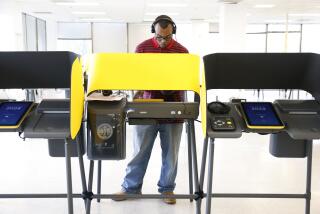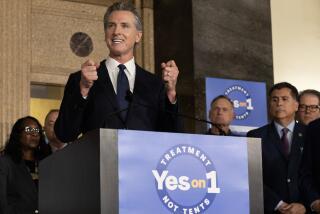California primary past
- Share via
When was the last time a California primary mattered? Some say 1968, when state Democrats selected Robert F. Kennedy, who was shot to death that night. But 1972 the start of the modern primary system, and the last time this paper endorsed a candidate was no sleeper as George McGovern sought the state’s 271 delegates to solidify his lead over Hubert Humphrey, the presumptive nominee. The Times reacted two days after the primary, on June 8, 1972:
Two Paths to Miami Beach
A few short months ago, it appeared almost impossible that Sen. George S. McGovern might win the Democratic presidential nomination, but Tuesday the Democratic voters of California placed the nomination almost within his grasp.
McGovern’s victory over Sen. Hubert H. Humphrey fell far short of the margin that a poll had found a week before the election. Nevertheless, he captured the state’s 271 convention delegates, and the importance of his victory cannot be discounted. In defeating Humphrey, McGovern beat a man who has been riveted into the political consciousness of the country for 25 years and who came close to winning the Presidency four years ago.
On the day he won in California, McGovern picked up 68 to 70 of New Jersey’s 109 convention delegates, 10 of New Mexico’s 18 and all 17 of the delegates in his home state, South Dakota. McGovern will go the convention with at least 1,100 of the 1,509 delegates needed for nomination, and he very likely will have accumulated considerably more by convention time.
The California primary demonstrated McGovern’s strength, but it also revealed his vulnerability. He was forced on the defensive by Humphrey’s attacks on his tax reform measures, his proposals to cut the defense budget by billions, and his income supplement proposals.
But as McGovern campaigned across the country, it became apparent that he had attracted to his banner a large and resourceful crew of bright, vigorous young men and women. The “new politics,” if there is a “new politics,” concerns basic issues, but the young men and women for McGovern have applied the old politics of careful organization and have used these methods with more skill than the party professionals. The new breed, whether or not they can put McGovern in the White House, may influence the Democratic Party and the country for years to come.
It may also be said that the absence of Gov. George C. Wallace’s name on the California ballot distorted the results. If Wallace had entered the primary and had been able to campaign, he undoubtedly would have drawn more votes than he received in a last-minute write-in drive.
And if there was any doubt before that President Nixon would lead a cohesive unified Republican Party into the November election, there was none after Tuesday’s California primary. Rep. John Ashbrook, a conservative opponent of the President made only a nominal showing. As if to underscore the point, the Republican voters of the 35th Congressional District defeated Rep. John G. Schmitz, an extreme right-wing Republican critic of Mr. Nixon.
But McGovern obviously has caught the mood of a large element in the Democratic Party. If this mood extends within and beyond the party and persists through the summer and fall, he could be a formidable candidate against President Nixon.
More to Read
Get the L.A. Times Politics newsletter
Deeply reported insights into legislation, politics and policy from Sacramento, Washington and beyond. In your inbox twice per week.
You may occasionally receive promotional content from the Los Angeles Times.










